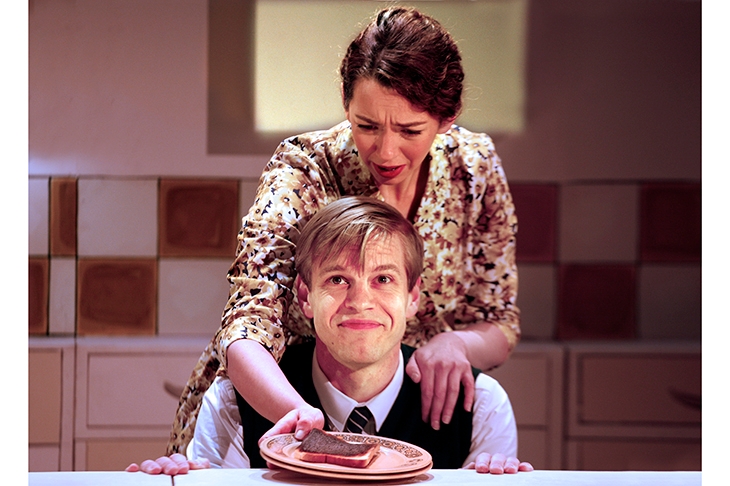Nigel Slater is popular because he’s an exceptionally meek cook. Not for him the sprawling restaurant empire or the transatlantic TV career to excite envy and loathing. He writes about his trade in simple vivid prose and his bestselling memoir, Toast, has become a play.
Young Nigel enters as a 1960s schoolboy, with shorts and a side parting, living in a posh suburb of Wolverhampton. Dad is a kindly but remote presence, an alien in his own home. Mum is a braindead kitchen-limpet who encourages Nigel’s first culinary experiments. The family are adventurous. They try spaghetti bolognese. Dad takes charge at the dinner table and loads each plate with a heap of yellow string topped by garnish the colour of lava spewed from a volcano. Nigel pronounces the dish quite good. Not hugely exciting but reasonable.
Much of the play is pitched at this undemanding level. Nigel tells us he likes smells and he also likes lists. Then he gives us a list of smells that he likes. Food junkies will be disappointed that the focus is on sweets rather than on cuisine, and the script includes a roll call of the oddly named confectionary available in the 1960s: Refreshers, Acid Drops, Flying Saucers, Black Jacks, Traffic Lights, Humbugs and Matchmakers. To modern ears these sound like Class-A drugs or dark-web cures for erectile dysfunction but half a century ago they were children’s primary source of sensory pleasure. During the first act, bags of chews and mints were passed along the rows and we were encouraged to rummage for a treat and wolf it down. In the interval we each received a Walnut Whip and a strict warning not to eat it until ordered to do so. These goodies rang alarm bells. Attempts to bribe or distract an audience suggest a lack of faith in the play as a dramatic effort.
That anxiety was justified. The play needs a larger cast and it has a glaring structural fault. The opening act centres on Nigel’s cheery relationship with his doting mum. Then something huge happens. It’s not clear what. Mum is suspected of a tryst with the strapping gardener and she succumbs to a condition that obliges her to ‘sit down’ a lot. Is she pregnant? Not sure. Anyway she disappears and in the darker second act Nigel struggles to form a relationship with Dad’s sexy new partner, Joan. Mum has gone and the first act seems to have counted for nothing.
The actors in this inventively staged show are great to watch. Giles Cooper gives a fine account of Slater’s amiable intelligence. Lizzie Muncey has little to work with as Mum but she returns in act two playing a hilariously demented teacher. Dad’s dollybird, Joan, is conjured up with swaggering eroticism by Marie Lawrence. She’s a nicotine addict. And it was Joan’s 20-a-day habit that carried me back to my boyhood in the 1960s, and to the long-forgotten horror of being kissed by a female smoker, fag in hand, who would puff on her death-stick and then stoop over you, her face scented with poison, and imprint her rosebud lips on your cheek as the evil smog poured from her nostrils.
The show is certainly gratifying as an evocation of memories but that’s as far as it goes. Ultimately it’s a nice documentary about a nice kid from a nice home who gets a nice job at the Savoy. I wanted more. And I wanted more accuracy too. Rolos were sold in packets, not from a jar, as shown on stage, and the vessel marked ‘Rolos’ contained Liquorice Allsorts.
Ghost Stories by Jeremy Dyson and Andy Nyman has returned to the Lyric where it originated. This postmodern horror show begins as a lecture about the paranormal that goes wrong when the speaker is abducted by Something Creepy from the afterlife. The lecturer introduces three stress-inducing tales. A jumpy security guard sifts through a deserted warehouse full of mannequins. A nervous solo driver smacks into an unidentified creature at night and then runs out of petrol with the creature still loose. A banker whose wife is pregnant wanders through the nursery that will shortly house their baby.
In each case the character is isolated, at around midnight, in a location replete with items that look harmless by day but which become scary after dark. In other words, the stories are contrived and even formulaic. In each case the character tours his surroundings and examines each possible source of nastiness until finally — bang! The shock is sprung. To judge by the petrified screams around me the show seemed to have worked its baffling magic. Fans claim that a good horror story delivers a brief and survivable jolt to the senses that makes an excellent conversation piece. So does being hit by a Tazer.







Comments